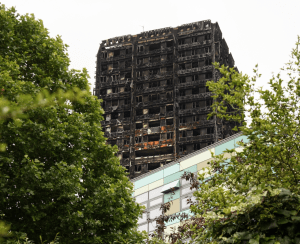This is what passive fire protection is all about. Restrict, slow, contain – flames, gasses and smoke.
When we think about fire safety, we think about fire alarms, sprinklers and good fire safety management practices. Top of mind in active fire safety is efficient escapes, fires put out and adjacent buildings being saved. Less likely to be considered is how the effects of fire and smoke are being limited within the building, and how the building’s structural components are being protected, so walls and ceilings don’t collapse before everyone has managed to get out. This is an almost invisible scenario and it’s all about passive fire protection.
 We can see active fire safety but, because we can’t see passive fire safety, it can be less compelling and rather less interesting, until we see the failure of passive fire protection in a disaster like Grenfell Tower (London 2017). And the failure of passive fire protection need not be this overt, this dramatic. However, where the two key aspects of passive fire protection are ignored in the design and build of new buildings, or short changed in the reworking of existing buildings, then we run the risk of ‘smaller disasters’ with ‘fewer casualties’ continuing to occur.
We can see active fire safety but, because we can’t see passive fire safety, it can be less compelling and rather less interesting, until we see the failure of passive fire protection in a disaster like Grenfell Tower (London 2017). And the failure of passive fire protection need not be this overt, this dramatic. However, where the two key aspects of passive fire protection are ignored in the design and build of new buildings, or short changed in the reworking of existing buildings, then we run the risk of ‘smaller disasters’ with ‘fewer casualties’ continuing to occur.
The two key aspects of passive fire protection are resistance to fire and reaction to fire. Resistance to fire is reducing the spread of fire by ensuring floors, walls and ceilings are built to limit the spread of fire. Reaction to fire is about the materials we choose to line the interiors of our buildings, and clad exteriors, to limit rapid smoke production and the spread of fire. Passive fire protection is about preventing fire and smoke moving rapidly inside a building, and protecting exterior walls and level- to-level combustion and spread.
Restrict, slow, contain – flames and smoke. Preventing smoke, hot gasses and flames from spreading. This is what passive fire protection is all about.
Delivering the promise of passive fire safety protection
Correctly specified, installed and maintained, passive fire protection simply works. It does what it’s designed to do. While others work actively with alarms, hoses, sprinklers, emergency exit signage and escape management plans, passive fire protection waits for the fire to start and then gets to work.
Yet, to work effectively, passive fire protection needs the same level of installation, inspection and signoff, the same regular tests, checks and accreditation as active fire protection planning and components. Without the right design, planning, materials selection, installation and sign-off at the completion of the building – new or refurbished – passive fire protection can and will be compromised. In the absence of effective active fire protection it is passive fire protection that prevents smoke choking passage ways, secure exit passages that will save people and help minimise the most devastating impacts of fire on the building itself, including the collapse of floors, walls and ceilings. Where active options might fail, passive components can save.
Allen Bestwick (Team Leader, Passive Fire), Pierre-Jacques Gandino (Fire Engineer) and Diane Chen (Fire Protection Designer) are key players in Origin’s passive fire protection team. Allen observes that passive fire protection has been specified in legislation for many years, but has only recently been taken seriously in New Zealand.
“In recent years we’ve been learning so much much more on site, and we’ve been able to include much more passive fire safety planning into the upfront design process in order to have passive fire protection ready for consent.”
Allen, Pierre-Jacques and Diane regard the planning and passive fire components, materials and
installation as important as the design, selection and installation of, for example, sprinklers and fire alarms. Allen says it’s important that passive fire safety planning happens as early as possible on any project.
“Whether it’s a new building or an existing building, we really want to be included up front in the design and planning. It’s hard to come late to a project and then appear to be impacting unfavourably on timeframes, budgets, traditional materials selection and tradies’ ways of working when we know how critical passive fire protection will be to the project. Passive fire protection is a much easier conversation to have from the outset.”
In summary – what passive fire protection achieves
In a building where fire is taking hold, passive fire protection restricts the spread of fire and smoke throughout a building where a fire has started, reduces the rapid spread of fire up or down the face of the building and protects neighbouring buildings.
Effective passive fire protection will ensure structural columns, beams, floors and walls stay stong enough to let occupants leave a burning building without injury. Within buildings, more rooms, apartments and service areas will remain habitable, business operations may be maintained and businesses remain viable.
Please see also one of our earlier stories: Successful passive fire protection. Avoiding the potential disaster awaiting developers.
